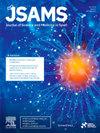‘Mind your head’, tackle characteristics associated with concussions in rugby league: A case-control study
IF 3
2区 医学
Q1 SPORT SCIENCES
引用次数: 0
Abstract
Objectives
Identify tackle characteristics associated with concussions in male professional rugby league.
Design
Case-control study.
Methods
Tackles resulting in 196 clinically diagnosed concussions and 6592 non-concussive tackles were analysed, from the men's rugby league Super League between 2018 and 2022. Eleven tackle characteristics were coded for each tackle, and Firth penalised logistic regression models were employed to identify influential variables through forward stepwise selection. Three multivariate models were produced; all (i.e., ball-carrier and tackler), tackler, and ball-carrier concussions.
Results
Of the 196 concussions, 70 % occurred to the tackler and 30 % to the ball-carrier. Initial impact location on the ball-carrier was identified as a predictor in all models, specifically the shorts, upper- and lower-leg (OR 9.1–12.3, compared to shoulder) for tacklers and head/neck (OR 66.1, compared to shoulder) for ball-carriers. Tackler head placement in front of the ball-carrier (OR 8.5, compared to away from the body) and a ball-carrier leading arm in any position (OR 4.8–22.1, compared to no leading arm) provided the greatest odds of a tackler concussion. For player's body position the greatest risk of concussion for all players was observed when both players were falling/diving (OR 8.8, compared to both players upright). One (OR 4.9, compared to two) and four (OR 3.7, compared to two) defender tackles provide the greatest odds for all concussions.
Conclusions
Concussion prevention strategies should aim to reduce head impacts by deterring initial contact with the ball-carrier's head/neck. Tackle technique should prioritise making initial impact with the torso and avoid the head being in front of the ball-carrier and any leading arms.
小心你的头",橄榄球联赛中与脑震荡有关的擒抱特点:病例对照研究。
目标: 确定男子职业橄榄球联赛中与脑震荡有关的擒抱特点:确定与男子职业橄榄球联赛中脑震荡有关的擒抱特点:设计:病例对照研究:分析了 2018 年至 2022 年期间男子橄榄球超级联赛中导致 196 例临床诊断脑震荡的擒抱动作和 6592 例非脑震荡擒抱动作。对每次擒抱的 11 个擒抱特征进行了编码,并采用 Firth 惩罚逻辑回归模型,通过前向逐步选择来确定有影响力的变量。产生了三个多变量模型:全部(即持球者和擒抱者)、擒抱者和持球者脑震荡:在 196 例脑震荡中,70% 发生在擒抱者身上,30% 发生在持球者身上。在所有模型中,持球者的最初撞击位置都是一个预测因素,尤其是短裤、上肢和下肢(与肩部相比,OR 值为 9.1-12.3)以及头部/颈部(与肩部相比,OR 值为 66.1)。擒抱者头部位于持球者前方(与远离身体相比,OR 值为 8.5),持球者的前臂位于任何位置(与无前臂相比,OR 值为 4.8-22.1),这两种情况导致擒抱者发生脑震荡的几率最大。就球员的身体位置而言,当两名球员都摔倒/跳水时,所有球员发生脑震荡的风险最大(OR 8.8,与两名球员都直立相比)。一名后卫(OR 4.9,与两名后卫相比)和四名后卫(OR 3.7,与两名后卫相比)擒抱造成脑震荡的几率最大:脑震荡预防策略应旨在通过阻止与持球者头部/颈部的初次接触来减少头部撞击。擒抱技术应优先考虑用躯干进行初次撞击,并避免头部位于持球者和任何前臂的前方。
本文章由计算机程序翻译,如有差异,请以英文原文为准。
求助全文
约1分钟内获得全文
求助全文
来源期刊
CiteScore
7.40
自引率
10.00%
发文量
198
审稿时长
48 days
期刊介绍:
The Journal of Science and Medicine in Sport is the official journal of Sports Medicine Australia (SMA) and is an an international refereed research publication covering all aspects of sport science and medicine.
The Journal considers for publication Original research and Review papers in the sub-disciplines relating generally to the broad sports medicine and sports science fields: sports medicine, sports injury (including injury epidemiology and injury prevention), physiotherapy, podiatry, physical activity and health, sports science, biomechanics, exercise physiology, motor control and learning, sport and exercise psychology, sports nutrition, public health (as relevant to sport and exercise), and rehabilitation and injury management. Manuscripts with an interdisciplinary perspective with specific applications to sport and exercise and its interaction with health will also be considered.

 求助内容:
求助内容: 应助结果提醒方式:
应助结果提醒方式:


